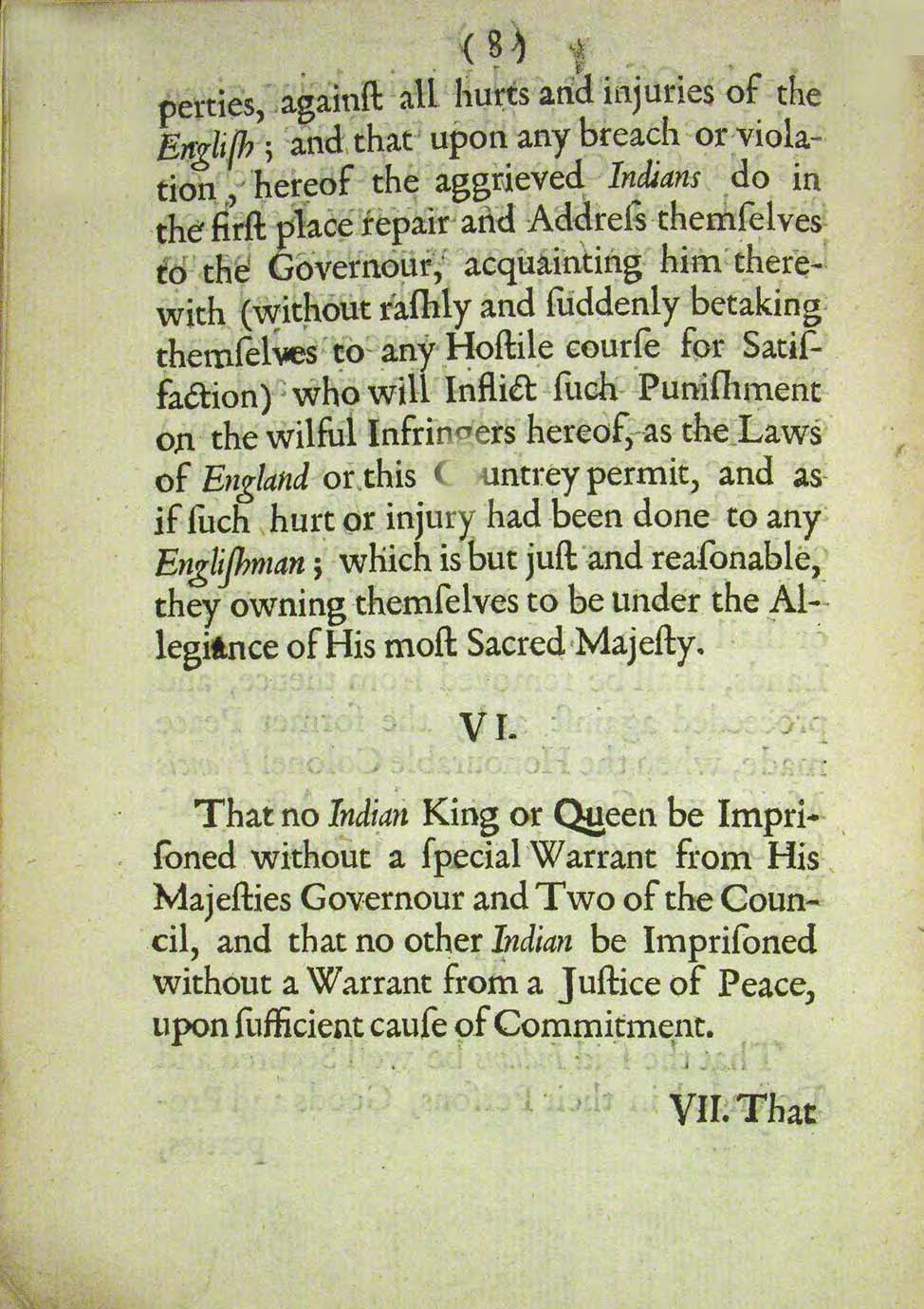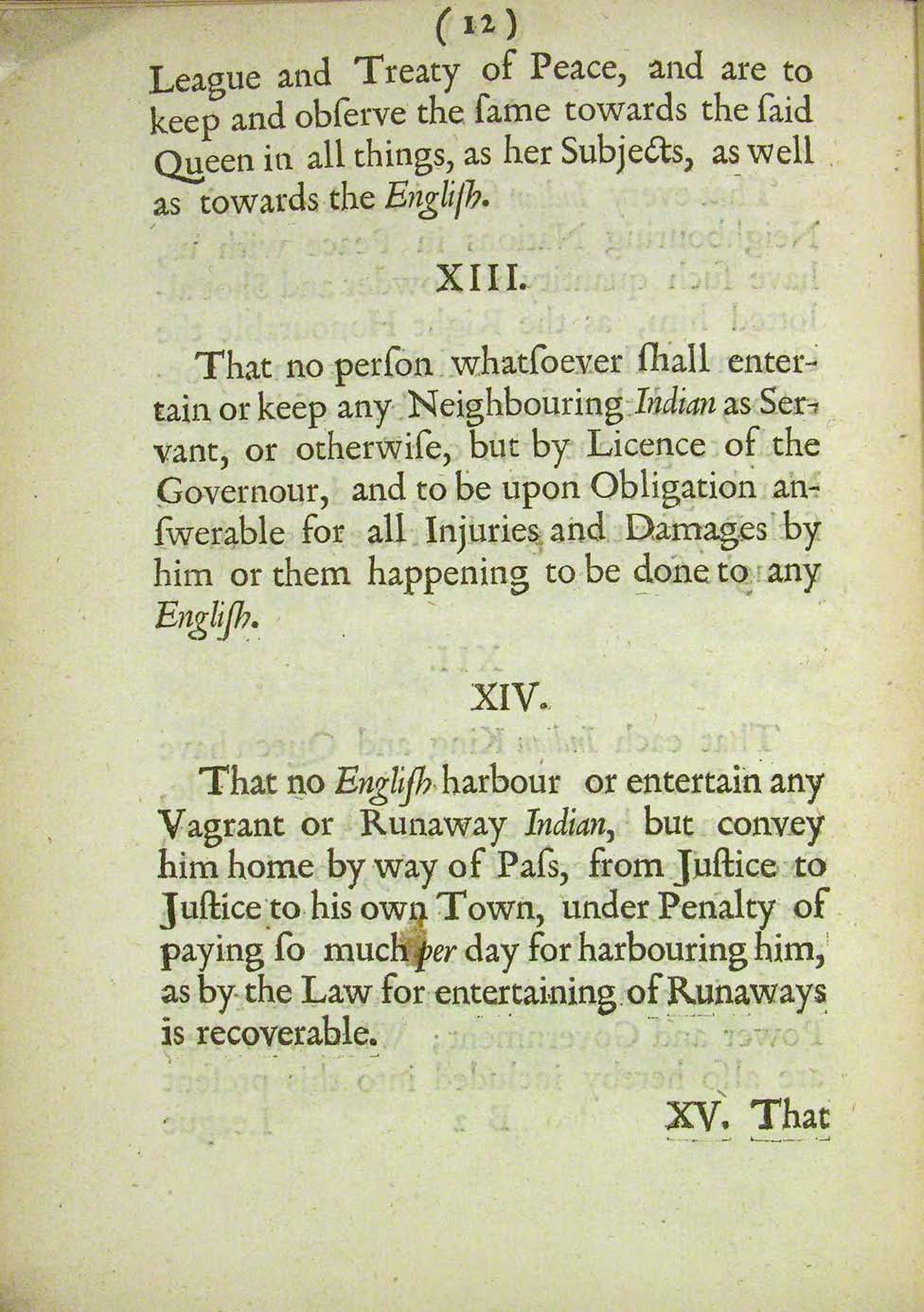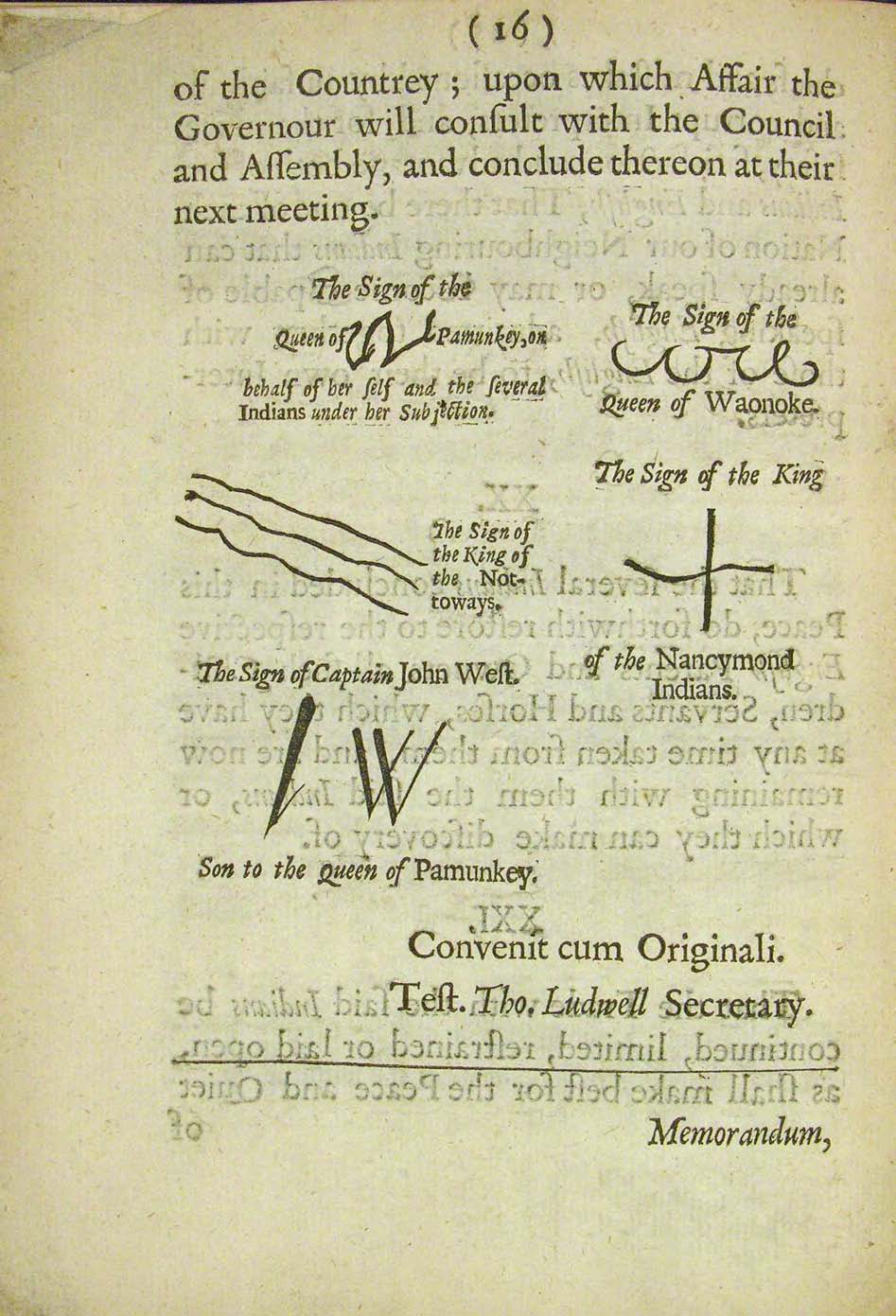Articles of Peace Between the Most Serene and Mighty Prince Charles II and Several Indian Kings and Queens ["The Treaty of Middle Plantation"]
By
Charles Stuart
OF
PEACE
Between
The Most Serene and Mighty PRINCE
CHARLES II.treaty
By the Grace of God,
King of England, Scotland, France and Ireland,
Defender of the Faith, etc.
And Several
Indian Kings and Queens, etc.
Concluded the 29th day of May, 1677.
Published by his Majesties Command.
London,
Printed by John Bill, Christopher Barker, Thomas Newcomb
and Henry Hills, Printers to the Kings
Most Excellent Majesty
1677. 3
Articles of Peace between the most Mighty Prince, and our Dread Sovereign Lord CHARLES the Second, by the Grace of God, King of Great Britain, France and Ireland, Defender of the Faith, etc. And the several Indian Kings and Queens, etc. Assenters and Subscribers hereunto, made and concluded at the Camp at Middle Plantation the Twenty ninth day of May 1677. being the day of the most happy Birth and Restauration of our said Sovereign Lordbirthday, and in the Nine and twentieth Year of His Majesties Reign, By the Right Honourable Herbert Jefferies Esquire, Lieutenant Governour of His Majesties Colony of Virginia.
Present,
The Honourable Sir John Berry Knight, and Francis Morison Esq; His most Sacred Majesties Comissioners appointed under the Great Seal of England for the Affairs of Virginia,
And The Honourable Council of State of the said Colony.
Whereas His most Sacred Majesty hath of His Own Royal Grace and meer Motion Intrusted to my Care and Endeavours the4 Renewing, Management, and Concluding a good Peace with the Neighbour Indians: In Order whereunto (with the Advice and Assistance of the Honourable Sir John Berry Knight, and Francis Morison Esquire) I have caused to be drawn up these ensuing Articles and Overtures, for the firm Grounding, and sure Establishment of a good and just Peace with the said Indians. And that it may be a Secure and Lasting one (Founded upon the strong Pillars of Reciprocal Justice) by Confirming to them their Just Rights, and by Redress of their Wrongs and Injuries, That so the great God (who is a God of Peace, and lover of Justice) may uphold and prosper this our Mutual League and Amity, It is hereby Concluded, Consented to, and mutually Agreed, as followeth;
5 Artic. I.That the respective Indian Kings and Queens do from henceforth acknowledge to have their immediate Dependency on, and own all Subjection to the Great King of England, our now Dread Sovereign, His Heirs and Sucessors, when they pay their Tribute to His Majesties Governour for the time being.
II.That thereupon the said Indian Kings and Queens and their Subjects, shall hold their Lands, and have the same Confirmed to them and their Posterity, by Patent under the Seal of this His Majesties Colony, without any Fee, Gratuity or Reward for the same, in such sort, and in as free and firm manner as others His Majesties Subjects have and enjoy their Lands and Possessions, paying6 yearly for and in lieu of a Quit Rent, or Acknowledgment for the same, onely Three Indian Arrows.
III.That all Indians who are in Amity with Us, and have not Land sufficient to Plant upon, be (upon Information) forthwith provided for, and Land laid out and Confirmed to them as aforesaid, never to be disturbed therein, or taken from them, so long as they own, keep and maintain their due Obedience and Subjection to His Majesty, His Governour and Government, and Amity and Friendship towards the English.
IV.Whereas by the mutual Discontents, Complaints, Jealousies and Fears of English and Indians, occasioned by the Violent Intrusions of divers English into their Lands, forcing the Indians by way of Revenge, to kill the Cattel and Hogs of the English,7 whereby Offence and Injuries being given and done on both sides, the Peace of this His Majesties Colony hath been much disturbed, and the late unhappy Rebellion by this means (in a great measure) begun and fomented, which hath Involved this Countrey into so much Ruine and Misery: For prevention of which Injuries and evil consequences (as much as possibly we may) for time to come; It is hereby Concluded and Established, That no English shall Seat or Plant nearer than Three miles of any Indian Town; and whosoever hath made, or shall make any Incroachment upon their Lands, shall be removed from thence, and proceeded against as by the former Peace made, when the Honourable Colonel Francis Morison was Governour, and the Act of Assembly grounded thereupon, is Provided and Enacted.
V.That the said Indians be well Secured and Defended in their Persons, Goods and Properties,8 against all hurts and injuries of the English; and that upon any breach or violation, hereof the aggrieved Indians do in the first place repair and Address themselves to the Governour, acquainting him therewith (without rashly and suddenly betaking themselves to any Hostile course for Satisfaction) who will Inflict such Punishment on the wilful Infringers hereof, as the Laws of England or this Countrey permit, and as if such hurt or injury had been done to any Englishman; which is but just and reasonable, they owning themselves to be under the Allegiance of His most Sacred Majesty.
VI.That no Indian King or Queen be Imprisoned without a special Warrant from His Majesties Governour and Two of the Council, and that no other Indian be Imprisoned without a Warrant from a Justice of Peace, upon sufficient cause of Commitment
9 VII.That the said Indians have and enjoy their wonted conveniences of Oystering, Fishing, and gathering Tuchahoetuckahoe, Curtenemonscurtenemons, Wild Oats, Rushes, Puckoonepuckoone, or any thing else (for their natural support) not useful to the English, upon the English Dividends; Always provided they first repair to some Publick Magistrate of good Repute, and inform him of their number and business, who shall not refuse them a Certificate upon this or any other Lawful occasion, so that they make due return thereof when they come back, and go directly home about their business, without wearing or carrying any manner of Weapon, or lodging under any Englishmans Dwelling-house one night.
VIII.That no Foreign Indian be suffered to come to any English Plantation without a friendly neighbor Indian in his company with such10 Certificate as aforesaid: and no Indian King is to refuse to send a safe Conduct with the Foreigner, upon any Lawful occasion of his coming in, and that no Indian do paint or disguise themselves when they come in.
IX.That all Indian Kings and Queens Tributary to the English, having notice of any March of strange Indians near the English Quarters or Plantations, do forthwith repair to some one of the next Officers of the Militia, and acquaint him of their Nation, number, and design, and which way they bend their course.
X.That if necessary, a convenient Party be presently sent out by the next Colonel of the Militia, to Aid, Strengthen, and joyn with our friendly Indians against any Foreign Attempt, Incursion or Depredation upon the Indian Towns.
11 XI.That every Indian fit to bear Arms, of the Neighbouring Nations in Peace with us, have such quantity of Powder and Shot allotted him, as the Right Honourable the Governour shall think sufficient on any occasion, and that such numbers of them be ready to go out with out Forces upon any March against the Enemy, and to receive such Pay for their good Services, as shall be thought fit.
XII.That each Indian King and Queen have equal Power to Govern their own People, and none to have greater Power then other, Except the Queen of Pamunkey, to whom several scattered Nations do now again own their ancient Subjection, and are agreed to come in and Plant themselves under her Power and Government; Who with her, are also hereby included into this present12 League and Treaty of Peace, and are to keep and observe the same towards the said Queen in all things, as her Subjects, as well as towards the English.
XIII.That no person whatsoever shall entertain or keep any Neighbouring Indian as Servant, or otherwise, but by Licence of the Governour, and to be upon Obligation answerable for all Injuries and Damages by him or them happening to be done to any English.
XIV.That no English harbour or entertain any Vagrant or Runaway Indian, but convey him home by way of Pass, from Justice to Justice to his own Town, under Penalty of paying so much per day for harbouring him, as by the Law for entertaining of Runaways is recoverable.
13 XV.That no Indian (of those in Amity with us) shall serve for any longer time then English of the like Ages should serve by Act of Assembly, and shall not be sold as Slaves.
XVI.That every Indian King and Queen in the Moneth of March every year, with some of their Great Men, shall tender their Obedience to the Right Honourable His Majesties Governour at the place of his Residence, whereever it shall be, and then and there pay the accustomed Tribute of Twenty Beaver Skins to the Governour, and also their Quit-Rent aforesaid, in acknowledgment they hold their Crowns and Lands of the Great King of England.
XVII.That due care be had and taken that those Indian Kings and Queens, their Great Men and Attendants that come on any Publick14 Business to the Right Honourable the Governour, Council or Assembly, may be accommodated with Provisions and Houseroom at the Publick Charge, and that no English Subject shall abuse, revile, hurt or wrong them at any time in word or deed.
XVIII.That upon the Discord or Breach of Peace happening to arise between any of the Indians in Amity with the English, upon the first appearance and beginning thereof, and before they enter into any open Acts of Hostility or War one against another, they shall repair to His Majesties Governour, by whose Justice and Wisdom it is concluded such Difference shall be made up and decided, and to whose final Determination the said Indians shall submit and conform themselves.
XIX.That for the preventing the frequent mischiefs15 and mistakes occasioned by unfaithful and corrupt Interpreters, and for the more safety, satisfaction, and advantage both of the Indians and English, That there be one of each Nation of our Neighbouring Indians that can already speak, or may become capable of speaking English, admitted together with those of the English, to be their own Interpreters.
XX.That the several Indians concluded in this Peace, do forthwith restore to the respective English Parents and Owners all such Children, Servants and Horses, which they have at any time taken from them, and are now remaining with them the said Indians, or which they can make discovery of.
XXI.That the Trade with the said Indians be continued, limited, restrained or laid open, as shall make best for the Peace and Quiet16 of the Countrey; upon which Affair the Governour will consult with the Council and Assembly, and conclude thereon at their next meeting.
The Sign of the Queen of Pamunkey, on behalf of her self and the several Indians under her Subjection.
The Sign of the Queen of Waonoke.
The Sign of the King of the Nottoways.
The Sign of the King of the Nancymond Indians.
The Sign of Captain John West. Son to the Queen of Pamunkey.
Convenit cum Originali.
Test. Tho. Ludwell Secretary.
17Memorandum the 29th day of May, 1677.
That this Instrument of Peace being Read and Expounded to the several Indian Kings and Queens then present (at the Court at Middle Plantation) by Interpreters Sworn truly to perform the same, the said Indian Kings and Queens Signed and delivered the Articles to the Honourable Governour upon their Knees, and received that other part, Signed and Delivered on behalf of the Kings Majesty, in the same posture of kneeling, of their own accords kissing the Paper as they Transferred it from hand to hand to each other, until every one had done the like Mark of Reverence to it, in sign of a most free and joyful acceptance of this Peace concluded with them. At the same time Pericuhtah King of the Appomatucks being then present, did earnestly desire to be admitted to the Signing this Peace with the rest; but he being suspected and Complained of to have Committed by himself or Subjects18 some Murthers on His Majesties Subjects of England, was not admitted or included into this League at that time, nor is to partake of the benefit of this Peace, before he shall have cleared himself of this Guilt imputed to him, and Committed since His Majesties Commissioners came into Virginia, as they were credibly informed: Which Exemption gave the English general satisfaction, to find there was so just Inquisition made of the Bloud of their Slaughtered Brethren.
John Berry, Francis Morison London Printed by John Bill, Christopher Barker, Thomas Newcomb and Henry Hills, Printers to the Kings Most Excellent Majesty 1677. treaty This document, most typically remembered as the “Treaty of Middle Plantation,” after the place where it was ratified (the site of present-day Williamsburg, Virginia) was signed in May 1677 by the governor representing the English colonial government and the leaders of several indigenous tribes, primarily the Pamunkey and Mattaponi, to bring an end to a series of conflicts between the English settlers and the native people of the region. The conflicts are most often referred to as “Bacon’s Rebellion” after the English settler Nathaniel Bacon, who in 1676 led attacks against native groups and then an armed uprising against William Berkeley, then the English governor, and his administration. The Rebellion is a complicated and often ugly story, but a key component was that Bacon and the colonists who joined him in rising up against their own government, argued that Berkeley was not sufficiently brutal to the native American population in the area, which Bacon wished to eliminate completely to clear land for settlement by English colonists. Bacon’s uprising exposed divisions with the colonists between the elite members of the government (which was in favor of promoting the intersts of settlers but not interest in sparking conflict with the native people) and the farmers, indentured servants, and also some enslaved African people who fought on Bacon’s side. But the conflict also exposed and exacerbated divisions with the local indigenous nations. Bacon and his followers burned the colonial capital of Jamestown down, but he died of unexpectedly of dysentery in October 1676. The rebellion lost its momentum with the loss of its leader. The British government restored order and executed some of the other central figures in the uprising. Berkeley, who seemed unable to please anybody, was relieved of his office and went back to England, where he died in July 1677. The English king, Charles II, sent a commission consisting of John Berry and Francis Morison to investigate the situation, as well as a new governor, Herbert Jeffreys, to replace the discredited Berkeley. The treaty to establish a durable peace was largely negotiated between the commissioners and a group of natives led by the Pamunkey leader Cockacoeske, who had become the most prominent representative of the indigenous people in the region. (We follow convention in identifying the “author” of the treaty as Charles Stuart or Charles II, as all royal proclamations and treaties were credited to him, but the terms were worked out on the ground, using language that followed legal and diplomatic precedent.) Under the terms of the treaty, the native peoples avowed their loyalty to the English crown. In return, the different tribes were recognized as sovereign over their own citizens, and were granted various kinds of protection against future attempts at violence against them by English settlers. Colonists were, for example, not allowed to claim any land within three miles of a native village. This in effect established the first reservations for indigenous people in territory that was becoming increasingly dominated by the English. The treaty also consolidated Cockacoeske, the “Queen of Pamunkey,” as the leader of the indigenous people of the area, insisting that other tribes declare their allegiance to her. The native people probably had reason to regret the terms of the treaty. English settlers often ignored the three-mile rule, and Cockacoeske had mixed success in getting other indigenous leaders to acknowledge her authority. But the Treaty of Middle Plantation remains in force to this day. Representatives of the Mattaponi and Pamunky people bring gifts such as turkey and deer to the Governor of Virginia each year, usually around Thanksgiving, in symbolic fulfillment of their obligations for the "tribute" called for by the treaty. In theory, the Treaty of Middle Plantation protected indigenous people from acts of violence and codified their sovereignty, something that Bacon and his followers would not have accepted. But the document is also one of many that marks the long history of the displacement of native people in the Americas from the lands that they had lived on for many centuries. - [JOB] birthdayMay 29th was indeed the birthday of Charles II, as well as the anniversary of the day that he had been restored to the English throne in 1660. It is impossible to know whether this is a coincidence, or whether the English commissioners planned the treaty signing to occur on a day that they knew that their boss considered to be an auspicious one. - [JOB] tuckahoeTuckahoe is a generic name for a number of marsh grasses that indigenous people used for food and medicine. - [JOB] curtenemonsCurtunemons is the Pamunkey word for the plant that English speakers usually call "dock"; it's a green that can be used fresh in salads or cooked. - [JOB] puckooneA Pamunkey word for a plant that the indigenous people used to make a dye for clothes. - [JOB]![Page [Title Page]](https://anthologyassetsdev.lib.virginia.edu/stuart-articles/pageImages/Stuart-title.jpg)















